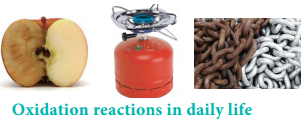Find free online Chemistry Topics covering a broad range of concepts from research institutes around the world.
Redox Reaction Examples, Types and Applications
When an apple is cut, it turns brown after sometime. Do you know the reason behind this colour change? It is because of a chemical reaction called oxidation. We come across oxidation reactions in our daily life. For example
1. Burning of LPG gas
2. Rusting of iron
3. Oxidation of carbohydrates, lipids, etc. into CO2 and H2O to produce energy in the living organisms.
All oxidation reactions are accompanied by reduction reactions and vice versa. Such reactions are called redox reactions. As per the classical concept, addition of oxygen (or) removal of hydrogen is called oxidation and the reverse is called reduction.
Fig. 1.4 Oxidation reactions in daily life

Consider the following two reactions.
Reaction 1:
4 Fe + 3O2 → 2 Fe2O3
Reaction 2:
H2S + Cl2 → 2 HCl + S
Both these reactions are oxidation reactions as per the classical concept. In the first reaction which is responsible for the rusting of iron, the oxygen adds on to the metal, iron. In the second reaction, hydrogen is removed from Hydrogen sulphide (H2S). Identity which species gets reduced.
Consider the following two reactions in which the removal of oxygen and addition of hydrogen take place respectively. These reactions are called reduction reactions as per the classical concept.
CuO + C → Cu + CO (Removal of oxygen from cupric oxide)
S + H2 → H2S (Addition of hydrogen to sulphur)
Oxidation-reduction reactions i.e. redox reactions are not always associated with oxygen or hydrogen. In such cases, the process can be explained on the basis of electrons. The reaction involving loss of electron is termed oxidation and gain of electron is termed reduction.
For example,
Fe2+ → Fe3+ + e– (loss of electron-oxidation).
Cu2+ + 2e– → Cu (gain of electron-reduction)
Redox reactions can be better explained using oxidation numbers.